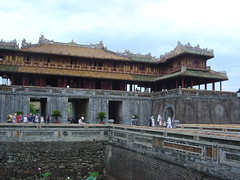The Nguyen Dynasty moved the capital of Vietnam from Hanoi to Hue, in the center of the country, to consolidate the north and the south. When they did, they built an enormous imperial palace modeled after the Chinese Forbidden City. The massive front gates for the complex are pictured here. Each gate was for a specific rank of person and only the emperor could use the large center gate.
The Nguyens only ruled Vietnam for less than 150 years beginning in the early 1800's, but their dynasty had enough palace intrigue and back-stabbing to rival any royal family westerners are familar with.
Our guide for the two days we were in Hue kept explaining the roles of the thirteen different emperors, but it was a lost cause for me to try to keep them straight. What makes it very confusing is that each emperor has a family name, a dynasty name, a temple name, and a posthumous name. For example, the founder of the dynasty had the family name of Nguyễn Phúc Ánh, but took the name of Gia Long when he became emperor. After his death, he was known as Cao Hoàng Đế and he is buried at the Thế Tổ Temple.
The Nguyens were a colorful lot. One emperor had over 60 children and another, as our guide delicately put it, preferred men to women. One emperor only lasted three days because the mandarins discovered he had forged the previous emperor's will. And that's just the juicy stuff I remember. Some future James Clavell has a rich tapestry to exploit here.

No comments:
Post a Comment